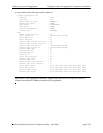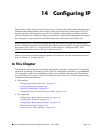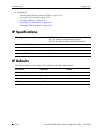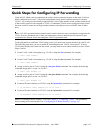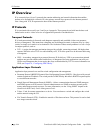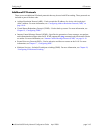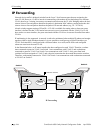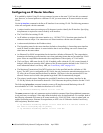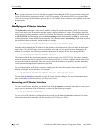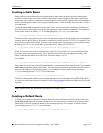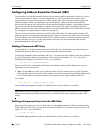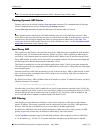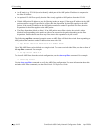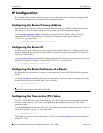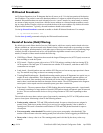
Configuring IP IP Forwarding
OmniSwitch 6600 Family Network Configuration Guide April 2006 page 14-7
Configuring an IP Router Interface
IP is enabled by default. Using IP, devices connected to ports on the same VLAN are able to communi-
cate. However, to forward packets to a different VLAN, you must create an IP router interface on each
VLAN.
Use the ip interface command to define an IP interface for an existing VLAN. The following parameter
values are configured with this command:
• A unique interface name (text string up to 20 characters) used to identify the IP interface. Specifying
this parameter is required to create or modify an IP interface.
• The VLAN ID of an existing VLAN.
• An IP address to assign to the router interface (e.g., 193.204.173.21). Note that router interface IP
addresses must be unique. You cannot have two router interfaces with the same IP address.
• A subnet mask (defaults to the IP address class).
• The forwarding status for the router interface (defaults to forwarding). A forwarding router interface
sends IP frames to other subnets. A router interface that is not forwarding can receive frames from
other hosts on the same subnet.
• An Ethernet-II or SNAP encapsulation for the interface (defaults to Ethernet-II). The encapsulation
determines the framing type the interface uses when generating frames that are forwarded out VLAN
ports. Select an encapsulation that matches the encapsulation of the majority of VLAN traffic.
• The Local Proxy ARP status for the VLAN. If enabled, traffic within the VLAN is routed instead of
bridged. ARP requests return the MAC address of the IP router interface defined for the VLAN. For
more information about Local Proxy ARP, see “Local Proxy ARP” on page 14-11.
• The Maximum Transmission Unit (MTU) packet size for the specified interface (defaults to 1500
bytes). The MTU size is configurable on all VLANs, but only restricts the transmission packet size for
VLANs with an IP router interface defined. In addition, 1500 bytes is also the maximum MTU size
allowed. Frames received with a data portion larger than 1500 are automatically dropped.
• The primary interface status. Designates the specified IP interface as the primary interface for the
VLAN. By default, the first interface bound to a VLAN becomes the primary interface for that VLAN.
The following ip interface command example creates an IP interface named Marketing with an IP
network address of 21.0.0.1 and binds the interface to VLAN 455:
-> ip interface Marketing address 21.0.0.1 vlan 455
The name parameter is the only parameter required with this command. Specifying additional parameters
is only necessary to configure a value other than the default value for that parameter. For example, both of
the following commands will create an IP router interface for VLAN 955 with a class A subnet mask, an
enabled forwarding status, Ethernet-II encapsulation, an MTU size of 1500 and a disabled Local Proxy
ARP and primary interface status:
-> ip interface Accounting address 71.0.0.1 mask 255.0.0.0 vlan 955 forward e2
mtu 1500 no local-proxy-arp no primary
-> ip interface Accounting address 71.0.0.1 vlan 955



